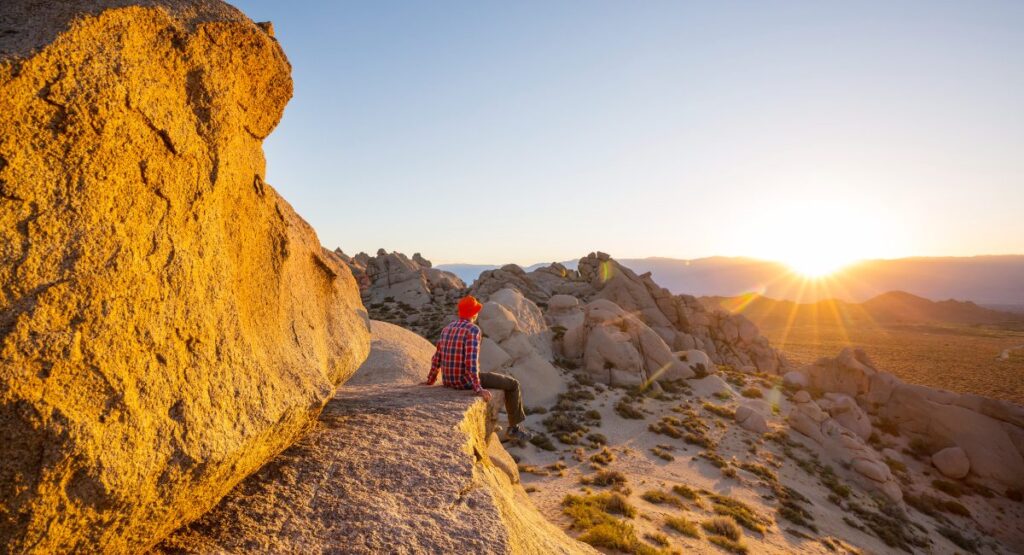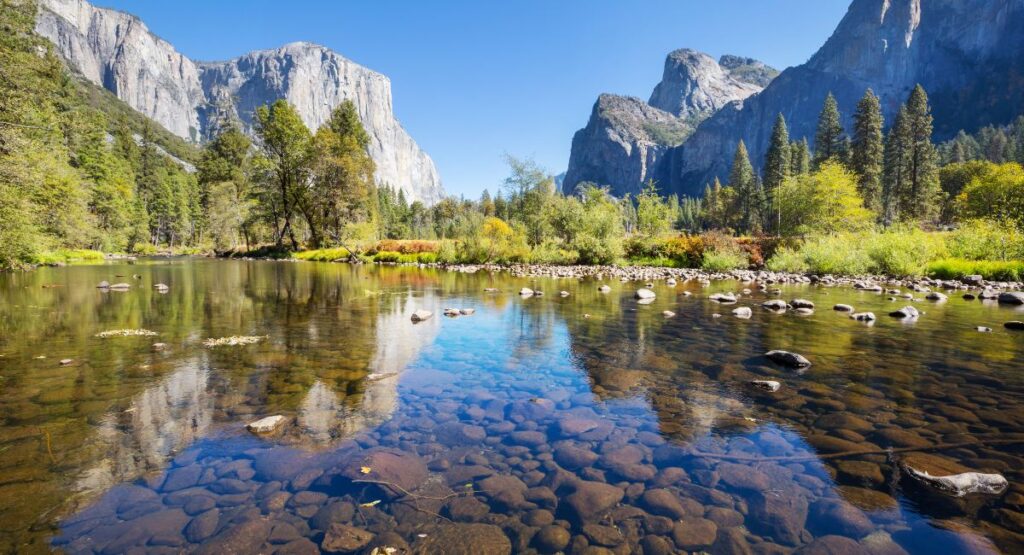Los Angeles is a bustling metropolis known for its glitz and glam and a prime gateway to some of the most breathtaking natural landscapes in the United States. This guide explores the top 5 national parks near Los Angeles, offering an escape for nature lovers and adventure seekers. From the arid deserts of Joshua Tree to the majestic forests of Yosemite, the landscape of California is truly stunning. When you rent an RV in los Angeles, you can explore these majestic sites from the comfort of a modern, fully-equipped RV, turning a simple trip into a memorable journey.
Overview of National Parks Near Los Angeles
Los Angeles’s unique geographical location offers unparalleled access to various national parks. Each park provides a distinct experience, whether you’re looking for rugged mountains, serene coastlines, or vast deserts. These parks not only preserve crucial habitats and wildlife but also serve as recreational havens for hiking, camping, and a host of other outdoor activities.
Joshua Tree National Park
Joshua Tree is the closest national park to Los Angeles. About a 2.5-hour drive from Los Angeles, this park is famed for its rugged rock formations and stark desert landscapes. The park gets its name from the Joshua trees scattered throughout the area. This desert oasis is a paradise for rock climbers, hikers, and stargazers. Joshua Tree’s otherworldly landscapes make it a top destination for those looking to escape the city.
Exploring Joshua Tree Campsites
Most, if not all, campsites in Joshua Tree National Park allow RVs under 35 feet in length. With an RV, you can enjoy the park’s serene environment without giving up the comforts of home, making it an ideal option for families and groups. Reserving a site is highly recommended if you plan to camp on a holiday, a weekend, or any day of the week in the spring. Our busy spring season runs from October to May.
Camping areas in Joshua Tree National Park
Black Rock Campground: Located in the northwest corner, this campground offers 99 sites, each with a picnic table and fire ring. Amenities include restrooms, water access, a day-use area, and a dump station. It’s five miles from Yucca Valley for supplies and has a designated equestrian area. The campground is suitable for tents and RVs.
Cottonwood Campground: Situated near the southeast’s Cottonwood Visitor Center, this reserved campground has 62 sites with drinking water and flush toilets, around 30 miles from Indio.
Indian Cove Campground: Off Highway 62, between Joshua Tree Village and Twentynine Palms, this site features 101 campsites, including thirteen for groups. Water is unavailable directly at the sites but can be refilled at the nearby ranger station. A filling station for RVs is located at the headquarters in Twentynine Palms.
Jumbo Rocks Campground: Offers 124 reservation-only sites, ideal for enjoying the stunning rock formations.
Ryan Campground: This central park location has 31 reservation-only sites, including four for equestrians. It lacks water facilities but offers three bicycle-specific sites at $5 per night.
Note: All reservation campgrounds are open year-round, but some sections of Indian Cove Campground, Black Rock, and Cottonwood Campground close in the summer.
Some camping sites are first-come-first-served in the park. They include Hidden Valley, White Tank, and Belle Campgrounds. Campsites, particularly during peak times and holidays, fill up quickly. Early week arrivals are recommended, and reservations can be made at recreation.gov
- Activities and Attractions in Joshua Tree The park is famed for its hiking trails, which range from easy walks to challenging hikes. The Arch Rock, Cholla Cactus Garden, and Hidden Valley offer unforgettable scenic views. Your RV serves as a cozy basecamp to return to after a day of exploring.
- How to Plan Your Visit Visiting Joshua Tree National Park in an RV during the cooler months allows for a comfortable and flexible travel experience, with easy access to the park’s many sites and activities. The best time to visit is from October to April. Ensure you have a good supply of water and sun protection to handle the desert climate.
Channel Islands National Park
Located just off the coast of Southern California, this park can be reached by boat or small aircraft. It’s about 70 miles from Los Angeles to the Ventura Harbor, where the park’s official concessionaire boats depart. The Channel Islands are known as North America’s Galapagos. This remote park is accessible only by boat or small plane, making it one of the most untouched natural environments in the state.
- How to Get to the Channel Islands The Channel Islands ferry is the most common way to reach the islands, with services departing from Ventura and Santa Barbara. The ferry services are operated by Island Packers. While the islands are only accessible by boat, your RV can be parked at a nearby ferry terminal in Ventura or Santa Barbara, providing secure and comfortable accommodations before and after your island adventure.
- Channel Islands Ferry Options Several ferry services offer trips to the islands, each providing unique tours or drop-off options. Booking in advance is recommended, especially during peak season. Here’s a brief description and trip details for the Channel Islands:
Anacapa Island Trips run year-round and have a flexible schedule of 3-7 days per week from Ventura and Oxnard Harbors. Just a one-hour journey brings you to Anacapa’s shores, where the adventure begins with a climb up steps to a dock, followed by a steel-rung ladder. Once on the island, get ready for a rewarding 157-step ascent to breathtaking views. Non-landing trips are also available if you prefer to stay on the water.
Santa Cruz Island: Catch a boat any day of the week, as trips leave Ventura Harbor frequently, up to 7 days a week. You’ll reach either Scorpion Anchorage or Prisoners Harbor in just an hour. Scorpion visitors will use an adjustable platform and a ramp, while those heading to Prisoners Harbor will climb a ladder to the pier. If the nearby pier is closed, you’ll have a fun beach landing instead!
Santa Rosa Island: From April through early November, heads out 2-4 days a week for a 3-hour sail from Ventura Harbor. Once you arrive, it’s a fun mix of climbing from the boat to a ladder and stairs to the pier at Bechers Bay. If the pier’s closed, your adventure begins with a skiff ride to the beach.
San Miguel Island is available from April through early November, and daily trips run 4-8 days a month. Prepare for a 4-hour sail from Ventura Harbor. You’ll land on the beach by boat, so make sure your gear is waterproof! Remember that the island’s wild beauty comes with possible strong winds and rough seas.
Note: Due to dock damage at Santa Barbara Island, Island Packers is not currently running trips to the island.
- Discovering the Unique Flora and Fauna The isolation of the Channel Islands has led to a high degree of biodiversity, including many unique species not found anywhere else on Earth. Guided tours offer insights into the islands’ ecological wonders. Some areas, like Santa Barbara Island, are temporarily closed to all public entry to protect breeding populations of California brown pelicans. The closure will continue until the end of the breeding season.
Sequoia and Kings Canyon National Parks

These two parks are adjacent and about a 3.5-hour drive north of Los Angeles. They are known for their giant sequoia trees, including the General Sherman tree, one of the largest trees on Earth. A drive through the towering forests of Sequoia and King’s Canyon National Parks in an RV is humbling and exhilarating.
- Touring Sequoia National Park Walking trails like the Congress Trail and Moro Rock provide panoramic views and close encounters with these ancient giants. Many of Sequoia’s campgrounds cater to RVs, offering spacious sites and hookups amidst the grandeur of nature.
- Giant Trees and Mountain Scapes Beyond the giant trees, the park features stunning mountain vistas, deep canyons, and robust wildlife. It’s a fantastic spot for photography, hiking, and witnessing the majesty of nature.
- Best Times to Visit Sequoia Spring through fall provides the most accessible weather conditions for exploring the park, though each season offers unique charms and challenges.
Death Valley National Park

Approximately 4.5 hours northeast of LA, Death Valley offers some of the region’s most extreme and compelling landscapes. As one of the hottest places in the world, Death Valley offers extreme adventures within its dramatic landscapes of sand dunes and salt flats. You can experience the extremes of Death Valley with all the comforts of home in one of RVRentalsOfAmerica’s premium RVs.
- Death Valley Camping and Accommodations: Several campgrounds and lodges within the park offer basic to comfortable accommodations. Due to the clear, dark skies, stargazing is particularly spectacular here.
Seasons and Camping Options
Summer (May – September): During the summer, extreme temperatures (sometimes over 100 degrees at midnight) mean few campgrounds are open, and they can get very crowded, especially over holiday weekends like Memorial Day, July 4, and Labor Day. Higher elevation campgrounds may be full most weekends. All open campgrounds operate on a first-come, first-served basis and are unmanned. Payments can be made at automated self-service kiosks using a credit or debit card. Due to the heat, camping is advised only in developed areas to avoid the risks associated with primitive roads, such as vehicle breakdowns and limited cell service.
Consider higher-elevation campgrounds like Mesquite Spring, Emigrant, or Wildrose for cooler conditions.
Winter/Spring (October – April): Furnace Creek Campground accepts reservations from October 15 to April 15 and often fills up during this busy season. Reservations can be made up to six months in advance at recreation.gov. Furnace Creek and Texas Springs campgrounds usually reach capacity on weekends and holidays, while Sunset Campground typically has availability even during peak times.
Choose from RV-specific sites that provide the necessary amenities to handle the harsh environment, ensuring a safe and comfortable base from which to explore the vastness of Death Valley. There are some restrictions in place for RVs in Death Valley:
- Mahogany Flats, Thorndike, and Wildrose Campgrounds: Max 25 feet.
- Emigrant Campground: Only tents, no RVs.
- Texas Springs and Mesquite Springs Campgrounds: Up to 35 feet.
- Furnace Creek Campground: Sites accommodate up to 100 feet (not all sites).
- Sunset Campground and Stovepipe Wells Campground: No RV length restrictions.
- Extreme Weather and Survival Tips: Visiting Death Valley requires preparation, especially regarding hydration and sun protection. Winter offers the most pleasant temperatures.
- Must-See Attractions in Death Valley: The Racetrack Playa, Zabriskie Point, and Badwater Basin are must-visit locations that showcase the park’s unique geological features.
Yosemite National Park

Although a bit further out, about a five-hour drive, Yosemite is one of the most famous and visited national parks in the United States. It is known for its waterfalls, valleys, meadows, and giant sequoias. The iconic landscapes of Yosemite are best enjoyed with the flexibility and comfort of traveling in an RV.
- Securing a Yosemite National Park Day Pass: Due to its popularity, entering Yosemite often requires a reservation, especially during the peak summer months. Day passes can be booked online ahead of your visit.
- Yosemite Highlights and Must-Visit Sites: Iconic sites like El Capitan, Half Dome, and Yosemite Falls are essential stops for any first-time visitor. The park’s extensive trail system caters to hikers and nature enthusiasts of all levels.
RV and Trailer Camping in Yosemite
Yosemite is an ideal destination for a long weekend getaway. Book one of the many RV-friendly campsites in Yosemite, which offer complete facilities and stunning views. Stay close to nature without sacrificing comfort.
Yosemite offers ten campgrounds suitable for RVs and trailers of various sizes, including fifth wheels. Overnight stays with RVs are allowed only in designated standard or RV campsites—not in parking lots, roadsides, or tent-only sites.
Reservations: These campgrounds are often fully booked from April through September. It’s advisable to reserve a spot as early as possible. Information on non-reservable camping is available for those without reservations.
Utilities: Yosemite has no electrical, water, or sewer hookups. However, dump stations with fresh water are accessible at Upper Pines Campground year-round, near Wawona Campground during summer and near Tuolumne Meadows Campground (which will reopen in summer 2024). Generators can be used only during specific hours: 7–9 a.m., 12–2 p.m., and 5–7 p.m.
RV and Trailer Sizes: The largest RVs allowed in Yosemite Valley are 40 feet, and the largest trailers are 35 feet, but only eight such spots are available. Many other sites can accommodate RVs up to 35 feet and trailers up to 24 feet. Sites typically have different maximum lengths for RVs and trailers due to the varied sizes of parking pads and turning spaces. Overextending site size limits are not advised, as alternative accommodations cannot be guaranteed if your vehicle doesn’t fit.
Food Storage: Food can be stored inside hard-sided RVs and trailers if it is out of sight and the unit is sealed (windows, doors, vents closed) when not present. Due to safety regulations, soft-sided campers like pop-up trailers must not be used for storing food.
Note: While the park is open, a reservation is required from 5 a.m. to 4 p.m. on some dates through October 27, 2024. April 13–June 30: weekends and holidays only. July 1–August 16: Daily. August 17– October 27: weekends and holidays only.
Frequently Asked Questions about National Parks Near Los Angeles:
Joshua Tree National Park is the closest national park to Los Angeles, located approximately 2.5 hours away by car. It’s an ideal spot for a quick getaway into stunning desert landscapes, easily accessible with an RV.
Sequoia National Park offers a range of activities, including hiking the Congress Trail, climbing Moro Rock for panoramic views, and marveling at the immense General Sherman Tree. Visitors can enjoy these activities year-round, and each season offers unique sights and experiences.
The drive from Los Angeles to Yosemite National Park typically takes about 5 hours and covers around 300 miles. The most scenic route is via CA-99 N and CA-41 N, which leads directly into the park. Renting an RV can make this journey comfortable and enjoyable, providing a flexible travel schedule and amenities.
When packing for a trip to Death Valley, include plenty of water, sun protection (sunscreen, hats, and long-sleeve clothing), comfortable hiking shoes, and layers for fluctuating temperatures. Also, ensure you have a well-stocked first-aid kit and emergency supplies in your RV, as some areas have limited services.
Guided tours are available in Channel Islands National Park, offering insights into the unique flora, fauna, and marine life. These tours range from day trips to extended excursions, with options including kayaking and hiking.

